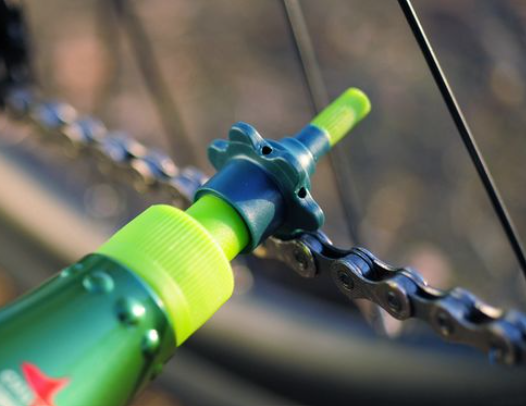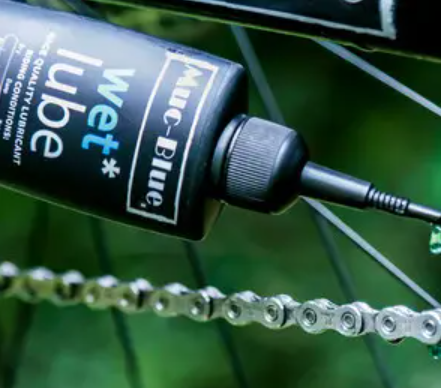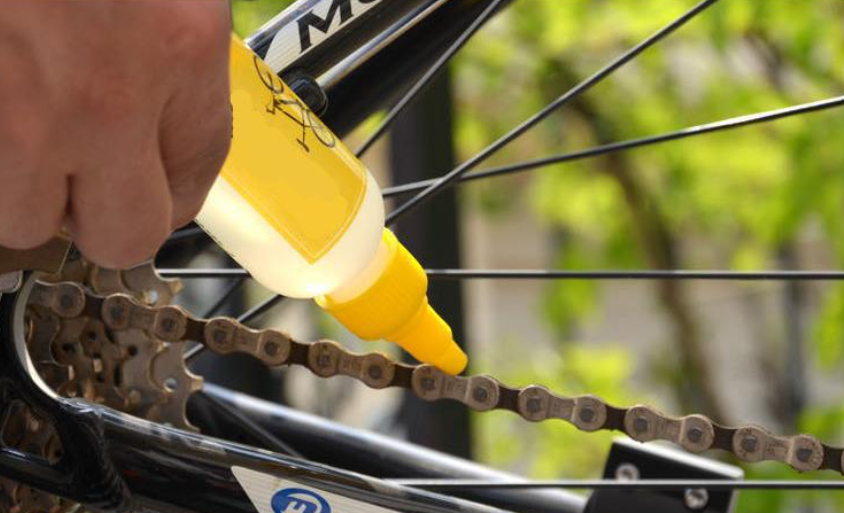As a manufacturer and wholesaler of bicycle parts, SUMLON noticed a lot of discussions about bike chain lube. And We’ve seen so many expensive lubricants. We saw tons of views on every bike chain lube out there online. SUMLON conceives that only certain viewpoints are correct.
1. Dry Bike Chain Lube
(1) What is dry lube?
Dry lube is typically a liquid or paste that forms a dry lubricating layer on the surface of the chain after application. This lubricating layer helps reduce friction between the chain and the drivetrain components, while also providing some resistance to the accumulation of dust and debris.

(2) Pros and cons – Dry lube
The lubricating layer formed by dry lube is dry, so it does not attract dust and dirt like other lubricants do. This helps keep the chain relatively clean. Dry lube can provide a lower coefficient of friction, thereby improving cycling efficiency and reducing wear on the drivetrain. However, dry lube typically has poor water resistance, so its effectiveness may diminish in wet or muddy conditions. In terms of longevity, the lubricating effect of dry lube is usually not as long-lasting as that of wet lube, requiring more frequent reapplication.
(3) Application scenarios – dry lube
Dry lube is particularly suitable for cycling in dry weather and road conditions, as it provides efficient lubrication while keeping the chain clean. Additionally, it’s a good choice for road cyclists and mountain bikers, especially when high riding efficiency and cleanliness are desired. Moreover, for short rides or daily commuters, dry lube is a convenient option as it allows for immediate cycling without waiting for drying.
2. Wet Bike Chain Lube
(1) What is wet lube?
Wet lube is typically composed of viscous liquid or grease, forming a long-lasting lubricating layer after application. This lubricating layer can resist water and extreme dirt conditions, providing lasting lubrication.

(2) Pros and cons – Wet lube
One of the main advantages of wet lube is its water resistance and durability. Due to its thick and viscous lubricating layer, it effectively protects the chain from moisture and dirt even in wet conditions. Additionally, wet lube typically provides longer-lasting lubrication, reducing the need for frequent chain lubrication. However, wet lube also has some disadvantages. Due to its viscous nature, it tends to attract more dust and debris, causing the chain and drivetrain to become dirtier more easily. Furthermore, its thick lubricating layer may increase friction in the drivetrain, reducing cycling efficiency.
(3) Application scenarios – wet lube
Wet lube is particularly suitable for use in wet or muddy conditions, as its water resistance and durability protect the chain from moisture and dirt. This is especially beneficial in harsh road conditions, such as rainy days or muddy mountain biking. Additionally, for daily commuters, wet lube is a convenient and reliable choice as it provides long-lasting lubrication, reducing the need for frequent lubrication.
3. Wax-based bike chain lube
(1) What is wax-based lube?
Wax-based lube is a type of dry lube. Its primary component is wax particles suspended in a solvent carrier. Once applied to the chain, the solvent evaporates, leaving behind a dry wax coating. This coating reduces friction between moving parts and helps repel dirt and debris.

(2) Pros and cons – Wax-based lube
The advantages of wax-based lube include its cleanliness and efficiency. The dry wax coating reduces friction in the drivetrain, making cycling smoother and quieter. It also repels dirt, keeping the chain and drivetrain cleaner for longer periods. Additionally, wax-based lubes provide long-lasting lubrication suitable for long rides and races without the need for frequent reapplication. However, wax-based lubes also have some limitations. They perform poorly in wet or muddy conditions as the dry wax coating can be quickly washed away, making the chain more prone to wear and rust. Furthermore, applying wax-based lube can be more time-consuming than other lubricants because it typically requires thorough cleaning of the chain before application to ensure good adhesion.
(3) Application scenarios – based dry lube
While it may require more time for application than other lubricants, wax-based lube excels in dry environments. Therefore, it is favored by road cyclists and riders in dry weather conditions. They are also preferred by long-distance riders and competitive cyclists because they provide long-lasting lubrication. However, their effectiveness diminishes in wet or muddy conditions.
4. Is Bike chain lube necessary?
A quick answer to this question is yes, but only for only a small group of riders. When you’re a road cyclist and ride at least 60 kilometers once a week, when you’re a mountain biker and partake in off-road biking for at least 2 hours weekly, when you’re a trekking bike rider and your daily mileage exceed 20 kilometers, then SUMLON strongly recommend the use of chain lubes. But if not, spending that much time and money on regularly lubricating your chain may not offer a cost-effective solution for you.
We’ve received numerous feedback comparing bikes with lubricated chains with those without lubricants. Testers haven’t noticed significant differences in bike performance. On the contrary, frequent application of dry lubes to their chains consumes a lot of time. While wet lubes are more durable than dry ones, the issue of oil sludge buildup becomes a bigger concern.
SUMLON agrees that chain lubes can extend the lifespan of chains and rear sprockets. However, constantly keeping your chain lubricated is very time-consuming, so you need to consider whether the benefits outweigh the costs. SUMLON‘s suggestion is that you only need to provide necessary lubrication to your chain when it starts making noise.
5. How often should you use bike chain lube?
If you don’t find lubricating your chain weekly to be a cumbersome task and decide to keep your bike’s drivetrain lubricated at all times like a pro, then you need to consider how frequently you should lubricate your chain.
This is a very simple question. Generally, when you hear your chain making strange noises, it’s time to add lubes to it. However, a more detailed recommendation is that if you’re using dry lube, you should add chain lube every 100 kilometers, and if you’re using wet lube, this number increases to 300 kilometers. It’s worth noting that wet lubes can leave a layer of sludge on the surfaces of your chain, chainring, and rear sprockets, so make sure to clean it promptly. Otherwise, your expensive rear sprockets will wear out faster.
6. Which lubrication should you choose for your chain?
You need to consider many factors.
(1)In terms of riding environment, if you often ride in wet or muddy conditions, choosing wet lube may be more suitable as it provides longer-lasting lubrication and better water resistance and durability in wet conditions. If you mainly ride in dry weather conditions, choosing wax-based dry lube may be more appropriate as it can provide a clean chain and good riding efficiency.
(2)In terms of riding distance, if you frequently engage in long-distance rides or races, you may prefer to choose a more durable lubricant, such as wet lube. Whereas, if you are doing short rides or daily commutes, you may prefer to choose dry lube, such as wax-based dry lube, as it does not attract dust and dirt, keeping the chain clean.
Wax-based lubes typically offer higher riding efficiency in dry conditions as they reduce chain friction and do not attract dust and dirt. Therefore, if you are seeking maximum riding efficiency, you may opt for wax-based lubes. However, wax-based lubes often require more frequent reapplication as their dry lubrication layer may degrade over a shorter period. In contrast, wet lubes generally offer longer-lasting lubrication, requiring less frequent reapplication. Therefore, you also need to consider whether you are willing to invest more time and effort in maintenance.
By the way, SUMLON has been manufacturing bicycle parts for over 15 years. Contact us if you are looking for a bike parts factory or a one-stop wholesaler. Peace




